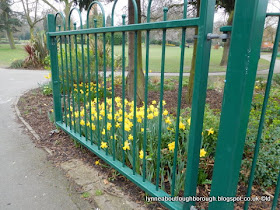I've already told you about the branding event I went to, but I've also been to several talks recently: a Loughborough Archaeological and Historical Society talk on Luddites in Arnold; a Friends of Charnwood Museum talk on Nanpantan Hall, and a talk in Heanor about nineteenth century policing in Derbyshire. If that weren't enough, I've also been to a book launch - of the Castle Donington volume of the Victoria County History series, in Donington Hall; a play about the Luddites in Loughborough, held at the Swan in the Rushes, and a play in Stratford about a [Ro]man who was Brutally killed (1). Little wonder I'm a bit behind on my course!
At the LAHS talk, given by Bob Massey (2), we learned of the Luddite connection to Arnold, in North Nottingham, which at the time of the attacks would have been a small, forested village, a part of Sherwood Forest. I've heard Bob speak on the topic before and he really does make it come alive: his enthusiasm for the Luddite story is catching. Bob told us that the, I don't know, let's call it the movement, was started in Arnold. He made suggestions as to why this was the case, including the fact that almost 2/3s of the population of the village was involved in framework knitting in the home.
Around 1812, when harvests were poor, and the country was paying the price for fighting the Napoleonic wars and the 1812-15 war with the United States, Britain also experienced a trade depression. Frames became more sophisticated, and bosses began to employ unskilled labourers (colts), who commanded lower pay rates than their skilled counterparts. The products made by the colts were inferior, but skilled workers were being offered the lower pay rates associated with the colts, and it is this that the Luddites were fighting against, rather than a general disgruntlement with the advancing technology.
Between the years of 1811 and 1812, there were many attacks which included attacks on Arnold, and there were many more both in the East Midlands and in Yorkshire. Framework breaking became a crime punishable by public hanging, and Bob told us that 29 Luddites were executed, and 34 transported.
Down at the Swan in the Rushes in Loughborough, one sunny Sunday afternoon in late March 2017, the Luddite attack on John Heathcoat and John Boden's factory in Mill Street (3) was acted out, and we witnessed one such execution, as James Towles was hung at the "New Drop", in front of the County Bridewell, Leicester (4), at the bottom of Horsepool Street (5), Leicester, for his part in the "Loughborough job". This public execution took place in November 1816, and was witnessed by large crowds. I don't know who was the Keeper of the County Bridewell at the time, but until a few years before this (until 1804) this post had been held by Daniel Lambert.
Back to the performance of the play, Last of the Luddites, by Chorus Theatre, and based on a book of the same name by local Loughborough man, Ian Porter (6), which told the story in an imaginatively unbiased way, reporting, via short court scenes, the events from the point of view of the witnesses, the jury and the victims. Central to the movement was Ned Ludd, from whom the Luddites got their name - if, of course he was real! The true story of Ned Ludd is not known, and many and various theories were explored throughout the play. Lord Byron (7), a supporter of the cause, as he perceived the Luddites were simply trying against all odds to make ends meet, also made an appearance.
Punishment was meted out to the Luddites who attacked Heathcoat and Boden's factory in Loughborough, and Heathcoat moved his factory to Tiverton (although it is thought he had already decided to do this before the actual attack), where he built houses and facilities for his workers, on a par with those provided by Cadbury for his workers, at Bournville (8).
At the conclusion of the play, the audience were encouraged to meet the cast, and ask questions centred around either the play itself, or the Luddite movement in Loughborough.
Here's a few pictures of the event.
(1) Julius Caesar by William Shakespeare
(2) http://www.arnold-history-group.org/29743483
(3) Mill Street is now Market Street, and the factory, which later became Wright's Mill, was situated where Iceland is today.
(4) A Bridewell was a house of correction, or prison, modelled on Bridewell Prison in London. Leicester's was on Highcross Street and you can still see some remains of this today. http://familylambert.net/History/bios/daniel.html
(5) According to an article in the Leicester Mercury, Horsepool Street is now Oxford Street in Leicester - difficult to imagine how this connected with Highcross Street, now with the underpass in the way. http://www.leicestermercury.co.uk/ringing-changes-street-names/story-12062400-detail/story.html
(6) Porter, Ian (2015) The last of the Luddites. Loughborough: Panda Eyes Publishing. 9780957102798
(7) The poet, Lord Byron, gave a speech in the debate in the House of Lords on the 1812 Frame breaking Act. http://www.luddites200.org.uk/LordByronspeech.html see particularly the final paragraph which describes the condition of some of these frame breakers.
(8) https://en.wikipedia.org/wiki/Bournville
And a shameless plug for some of my previous blogposts:
Various posts about the connections between Loughborough and Tiverton, Loughborough, Luddites and Lace, Picnic in the Park 2016, etc..
If you want to explore some of the locations in Loughborough that have associations with the Luddites, pop over to my virtual walk - or, better still, go for an actual walk around the area!!
You are welcome to quote passages from any of my posts, with appropriate credit. The correct citation for this looks as follow:
Dyer, Lynne (2017). Luddites in Loughborough and Arnold. Available from: http://lynneaboutloughborough.blogspot.com/2017/03/luddites-in-loughborough-and-arnold.html [Accessed 26 March 2017]






































































